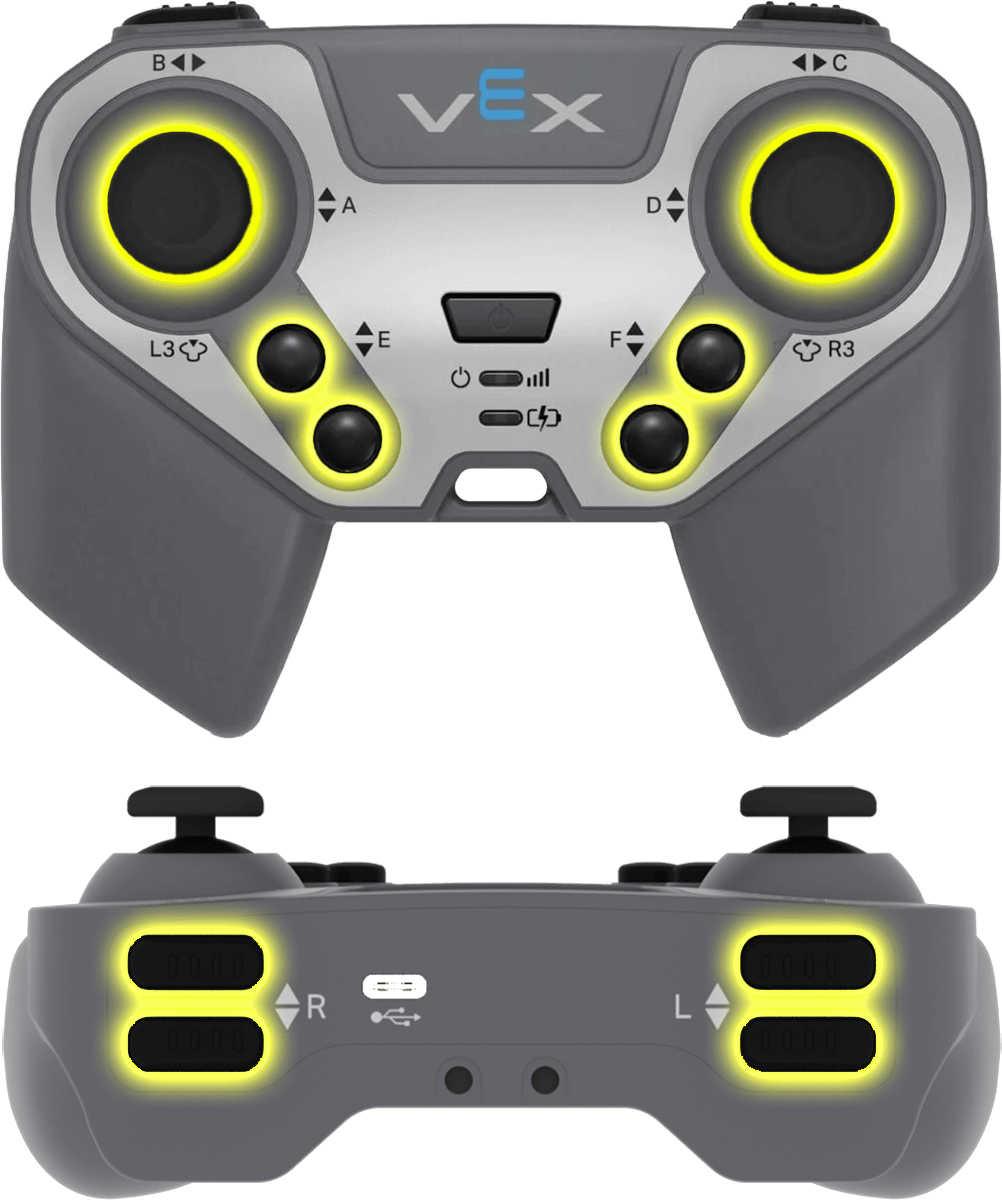Controller#
Introduction#
The IQ (2nd gen) Brain can connect to either an IQ (2nd gen) or IQ (1st gen) Controller. Both controllers have two analog joysticks and multiple buttons that the Brain can use to detect movements and presses.
For the examples below, the configured controller will be named controller and will be used in all subsequent examples throughout this API documentation when referring to Controller class methods.
Below is a list of all available methods:
Actions – Turn Controller-programmed actions on or off.
remote_control_code_enabled– Enable or disable Controller configured actions.
Getters – Read button states and joystick positions.
.pressing– Returns whether the specified button is being pressed..position– Returns the position of the joystick’s specified axis.
Callback – Run code when buttons or joysticks change state.
.pressed– Calls a function when the specified button is pressed..released– Calls a function when the specified button is released..changed– Calls a function when the joystick’s axis changes.
Constructors – Manually initialize and configure the controller.
Controller– Create a controller.
Actions#
remote_control_code_enabled#
remote_control_code_enabled is a variable that can be set to a boolean that enables or disables Controller configured actions from the Devices menu. The Controller is enabled by default. It can be set to either of the following:
True— Enable Controller configured actions.False— Disable Controller configured actions.
Usage:
remote_control_code_enabled = False
# Drive forward or backward using the left joystick
remote_control_code_enabled = False
while True:
if controller.axisA.position() > 0:
drivetrain.drive(FORWARD)
elif controller.axisA.position() < 0:
drivetrain.drive(REVERSE)
# Press E Up to use the controller configured actions
elif controller.buttonEUp.pressing():
break
else:
drivetrain.stop()
wait(20, MSEC)
remote_control_code_enabled = True
Getters#
.pressing#
.pressing returns an integer indicating whether a specific button on the controller is currently being pressed. This method must be called on a specific button object, such as buttonEDown (see full list of button objects below).
1- The specified button is being pressed.0- The specified button is not being pressed.
Usage:
One of five available button objects can be used with this method, as shown below:

Button |
Command |
|---|---|
|
|
|
|
|
|
|
|
|
|
|
|
|
|
|
|
|
|
|
|
Parameters |
Description |
|---|---|
This method has no parameters. |
# Turn right while E Up is held
while True:
if controller.buttonEUp.pressing():
drivetrain.turn(RIGHT)
else:
drivetrain.stop()
.position#
.position returns the position of the joystick’s specified axis as an integer from –100 to 100, representing a percentage. This method must be called on a specific axis object, such as axisA (see full list of axis objects below).
Usage:
One of four available axes can be used with this method, as shown below:

Axis |
Command |
|---|---|
|
|
|
|
|
|
|
|
Parameters |
Description |
|---|---|
This method has no parameters. |
# Turn with the left joystick
remote_control_code_enabled = False
while True:
if controller.axisB.position() > 10:
drivetrain.turn(RIGHT)
elif controller.axisB.position() < -10:
drivetrain.turn(LEFT)
else:
drivetrain.stop()
wait(20, MSEC)
Callback#
.pressed#
.pressed registers a function to be called when a specific button on the controller is pressed. This method must be called on a specific button object, such as buttonEDown – (see full list of button objects below).
Usage:
One of the available button objects can be used with this method, as shown below:

Button |
Command |
|---|---|
|
|
|
|
|
|
|
|
|
|
|
|
|
|
|
|
|
|
|
|
Parameters |
Description |
|---|---|
callback |
A function that is previously defined to execute when the specified button is being pressed. |
arg |
Optional. A tuple containing arguments to pass to the callback function. Functions with Parameters for more information. |
# Drive forward when E Up is pressed
def drive_forward():
drivetrain.drive_for(FORWARD, 100, MM)
controller.buttonEUp.pressed(drive_forward)
.released#
.released registers a function to be called when a specific button on the controller is released. This method must be called on a specific button object, such as buttonEDown – (see full list of button objects below).
Usage:
One of the available button objects can be used with this method, as shown below:

Button |
Command |
|---|---|
|
|
|
|
|
|
|
|
|
|
|
|
|
|
|
|
|
|
|
|
Parameters |
Description |
|---|---|
callback |
A function that is previously defined to execute when the specified button is released. |
arg |
Optional. A tuple containing arguments to pass to the callback function. Functions with Parameters for more information. |
# Drive backward when F Down is released
def back_up():
drivetrain.drive_for(REVERSE, 100, MM)
controller.buttonFDown.released(back_up)
.changed#
.changed registers a function to be called when the joystick’s position changes. This method must be called on a specific axis object, such as axisA (see full list of axis objects below).
Usage:
One of four available axes can be used with this method, as shown below:

Axis |
Command |
|---|---|
|
|
|
|
|
|
|
|
Parameters |
Description |
|---|---|
callback |
A function that is previously defined to execute when the axis’ value changes. |
arg |
Optional. A tuple containing arguments to pass to the callback function. See Functions with Parameters for more information. |
# Play a sound when the right joystick moves
def beep():
brain.play_sound(SoundType.TADA)
wait(1, SECONDS)
controller.axisD.changed(beep)
Constructors#
Constructors are used to manually create Controller objects, which are necessary for configuring a controller outside of VEXcode.
Controller#
Controller creates a controller.
Usage:
Controller()
Parameters |
Description |
|---|---|
This constructor has no parameters. |
# Create a Controller object
my_controller = Controller()
